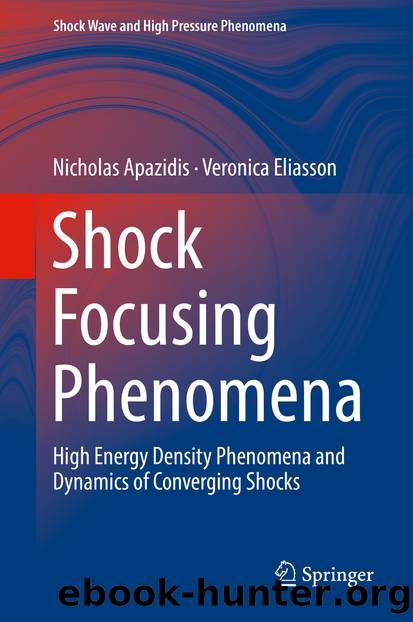Shock Focusing Phenomena by Nicholas Apazidis & Veronica Eliasson

Author:Nicholas Apazidis & Veronica Eliasson
Language: eng
Format: epub
Publisher: Springer International Publishing, Cham
Fig. 3.46Square shock convergence using four 15 mm diameter cylinders to shape the shock. (a) Îtâ=â0 μs. (b) Îtâ=â10 μs. (c) Îtâ=â18 μs. (d) Îtâ=â20 μs. (e) Îtâ=â22 μs. (f) Îtâ=â28 μs. (g) Îtâ=â31 μs. (h) Îtâ=â31 μs, reproduced from [42], with permission from Springer
As we saw, the presented experimental method makes it possible to tailor the form of converging shock by placing an array of small cylindrical obstacles in the chamber. The stability and symmetry of the converging shock are essential for its ability to produce high-energy density in gas at the focal region. The extreme conditions in gas are manifested by high pressures and temperatures leading to luminescence of the heated gas core visible to a naked eye. The main purpose of the work by Eliasson et al. [41] was to investigate the connection between the form of the converging shock and light emission levels of the compressed gas experimentally. The annular shock tube facility at KTH, Stockholm, with a central body is shown in the sketch in Fig. 3.47. An optical system consists of a mirror with beam expander and a lens provided for visualization by laser pulses and a schlieren imaging for capturing the form of converging shock fronts.
Fig. 3.47The annular part of the shock tube: 1. inner body with a cone, 2. supports, 3. mirror, 4. beam expander, 5. lens, 6. test section, reproduced from [41], with permission from Springer
Download
This site does not store any files on its server. We only index and link to content provided by other sites. Please contact the content providers to delete copyright contents if any and email us, we'll remove relevant links or contents immediately.
| Fluid Dynamics | Thermodynamics |
The Complete Stick Figure Physics Tutorials by Allen Sarah(7307)
Secrets of Antigravity Propulsion: Tesla, UFOs, and Classified Aerospace Technology by Ph.D. Paul A. Laviolette(5309)
Thing Explainer by Randall Munroe(3877)
The River of Consciousness by Oliver Sacks(3538)
The Order of Time by Carlo Rovelli(3145)
How To by Randall Munroe(3033)
A Brief History of Time by Stephen Hawking(2960)
I Live in the Future & Here's How It Works by Nick Bilton(2935)
The Great Unknown by Marcus du Sautoy(2646)
What If?: Serious Scientific Answers to Absurd Hypothetical Questions by Randall Munroe(2637)
Midnight in Chernobyl by Adam Higginbotham(2483)
Blockchain: Ultimate Step By Step Guide To Understanding Blockchain Technology, Bitcoin Creation, and the future of Money (Novice to Expert) by Keizer Söze(2445)
Networks: An Introduction by Newman Mark(2360)
The Meaning of it All by Richard Feynman(2300)
Easy Electronics by Charles Platt(2281)
The Tao of Physics by Fritjof Capra(2229)
Midnight in Chernobyl: The Untold Story of the World's Greatest Nuclear Disaster by Adam Higginbotham(2177)
When by Daniel H Pink(2082)
Introducing Relativity by Bruce Bassett(2076)
